
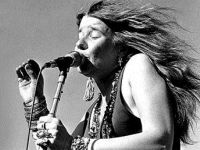

|
 |
|
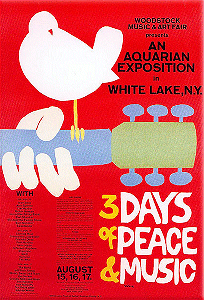 |
The
Woodstock Music and Art Fair, held in the Catskill Mountains of New York's
Sullivan County, showcased a veritable who's who of the top performers of
rock, folk, and progressive popular music during the Sixties era. To this
remote location was attracted an audience estimated at between a quarter
and a half-million mostly young people from all over the country. For the
three summer days over which it was held, the Festival site was said to
constitute the Empire State's second most populous city. The site itself
had been selected by the Festival's organisers because it comprised a natural
amphitheatre that afforded decent acoustics and unobstructed sight views,
plus plenty of space for camping on the grounds.
|
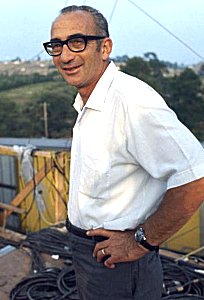 |
The Woodstock Festival happened in a kind of backhanded way. Two New York venture capitalists, John Roberts and Joel Rosenman, placed an ad in the New York Times stating simply "Two young men with unlimited capital looking for interesting, legitimate investment opportunities and business propositions." The ad immediately caught the eye of Michael Lang (right), a self- identified hippie rock promoter, who had just organised his first moderately successful festival in Miami. He and partner Artie Kornfeld were seeking finance to build a recording studio in the Hudson River Valley town and bohemian enclave of Woodstock (Ulster County), N.Y. The town had been known as a haven for artists and writers since the turn of the century, and by the mid-1960's had begun to attract a host of well known musicians such as Bob Dylan and the Band. Roberts and Rosenman were unimpressed by the basic proposal since they had already financed a recording studio and were looking for new ventures to pursue. However, Lang and Kornfeld's prospectus included the idea of staging a rock festival to promote the studio's opening and raise funds for its operation. That part of their proposal captured the investors' fancy and together the four men embarked upon the project of organising a festival at Woodstock. Lang pursued contacts in the entertainment industry and secured the services of John Morris who had recently been fired as manager of Bill Graham's Fillmore East auditorium in New York City. Morris successfully signed every act that had been booked to perform at the Fillmore East that same summer. Having these and other musicians would make the Woodstock Festival the largest gathering of rock and pop talent ever assembled on a single bill. When it was determined that there was no site in the village of Woodstock to accommodate a crowd expected to number 30 - 50,000, their search by helicopter into what seemed like every nook and cranny within a few hours drive of New York City led them eventually to the Sullivan County dairy farm of Max Yasgur (left). For $50,000 (and $75,000 in escrow to cover damages) he agreed to lease them several hundred acres including a 37½ acre alfalfa field that formed a natural amphitheatre and would make an ideal performance space. In total, 'Woodstock Ventures' leased 600 acres from Yasgur and other landowners for the festival grounds. The promoters failed utterly in restricting access to the site while preparations were being made, with the result that some 50,000 people had already arrived there before the fences had been completed. Realising how difficult, probably impossible, it would be to clear the field and force those early arrivals to show their tickets at the gate, the decision was taken to bow to reality and declare that it would be, henceforth, a free Festival. This guaranteed that the promoters would lose money on their venture, mitigated only by the hope that revenue from the release of the film and audio recordings would help them recoup their losses (which, more than a decade later, it did). Meanwhile approximately 85,000 others congregated in one of the other adjoining areas. |
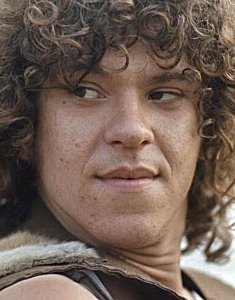 |
 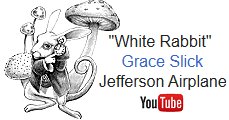 |
 |
When the festival started a few hours later, the first performer on stage
was Richie Havens. He greeted the crowd by loudly observing, "We've finally
made it! We did it this time -- they'll never be able to hide us again!"
He later wrote in his memoirs: "We were there because we felt good about
ourselves, happy to be in the same place with so many brothers and sisters
who shared this common bond. We were there to look at each other, meet each
other, identify our support for each other. We were there to celebrate.
We would share this experience the rest of our lives".
For Havens, as it would be later described
by other participants, the experience was first and foremost about "the
feeling that Bethel was such a special place, a moment when we all felt
we were at the exact centre of true freedom." Back on stage for an unprecedented
seventh and final encore, Havens improvised the song "Freedom," which then
became his signature tune. It also helped establish one of the Festival's
key themes. Another notable performer on that Friday was Country Joe McDonald who agreed to follow Richie Havens when Sweetwater had still not arrived. Without the rest of his band, the Fish, he agreed to play solo. McDonald opened his set with the infamous 'Fish Cheer': "Gimme an F!" he cried out, and the crowd, now numbering a quarter of a million, enthusiastically roared back "F!" "Gimme a U!" The call-and-response ended with what had to be the loudest uttering of an obscenity ever. |
| Another factor
was the notable lack of violence among the festival-goers. Because nothing
had been organised on this scale before, the Woodstock Festival took on
the aspect of a high stakes experiment where both the organisers and those
in attendance grasped the need to improvise solutions to the many challenges
they were faced with. Festival-goers reported feeling a sense of accomplishment
and exhilaration that together they found solutions to these challenges.
Later festivals tended to be better organised because of the Woodstock experience
and, when they were not, crowds tended to be much less willing to put up
with conditions they found wanting. In 1969 rock critic Ellen Sander appraised the impact of the Festival this way: "No longer can the magical multi-coloured phenomenon of pop culture be overlooked or underrated. It's happening everywhere, but now it has happened in one place at one time so hugely that it was indeed historic .... It was major entertainment news that the line-up of talent was of such magnificence and magnitude (thirty-one acts, nineteen of which were colossal). These were, however, the least significant events of what happened over the Woodstock weekend. What happened was that the largest number of people ever assembled for any event other than a war lived together intimately and meaningfully and with such natural good cheer that they turned on not only everyone surrounding them but the mass media and, by extension, millions of others, young and old, particularly many elements hostile to the manifestations and ignorant of the substance of pop culture." Woodstock was the culmination of a transformation in American popular music that had begun with Monterey. The Monterey Pop Festival introduced the emerging acid rock bands of the San Francisco Bay Area to a wider audience estimated at 50,000 people as well as to influential record executives and producers from New York and Los Angeles. Woodstock introduced the same wide diversity of talent, albeit on an expanded scale, to a truly mass audience and not just to those who attended the Festival. A subsequent documentary film (the Academy Award-winning 3-hour long Woodstock, directed by Michael Wadleigh and released in March 1970) and several sound recordings helped establish what had, only two years before, been underground or avant-garde musical styles and ushered them into the mainstream. What is apparent is that, although the original Festival can never be duplicated, the very notion of Woodstock retains an enduring grip upon many people's imagination. Woodstock as an idea is portable. Indeed, the 1969 Festival had been shifted from place to place in search of a site, before landing in Bethel. While festivals bearing the Woodstock name may continue to be held elsewhere and succeed by drawing on the cache of the original 'Aquarian Exposition', the Yasgur Farm site will no doubt maintain its vaunted status as the authentic location of one of the Sixties' most celebrated events. Also see: Bill Harry's Sixties: 1967 - The Summer of Love and Sixties City Events 1969 |
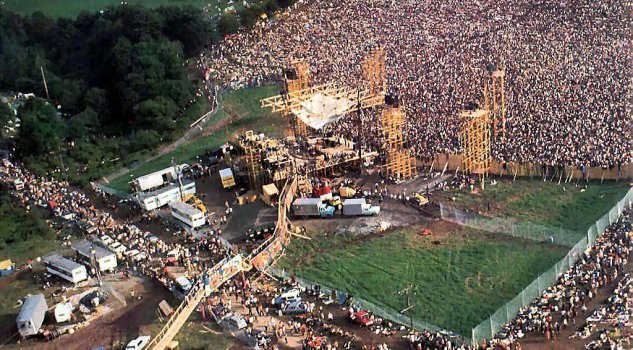 |
|
All
the above text is edited from the 'Statement on the Historical and Cultural
Significance of the 1969 Woodstock Festival Site' authored by Michael
Wm. Doyle Ph.D., Ball State University, Muncie, Indiana for Allee King
Rosen & Fleming, Inc., on behalf of the Gerry Foundation, Inc.
|
|
|
All
Original Material Copyright SixtiesCity
Other individual owner copyrights may apply to Photographic Images |